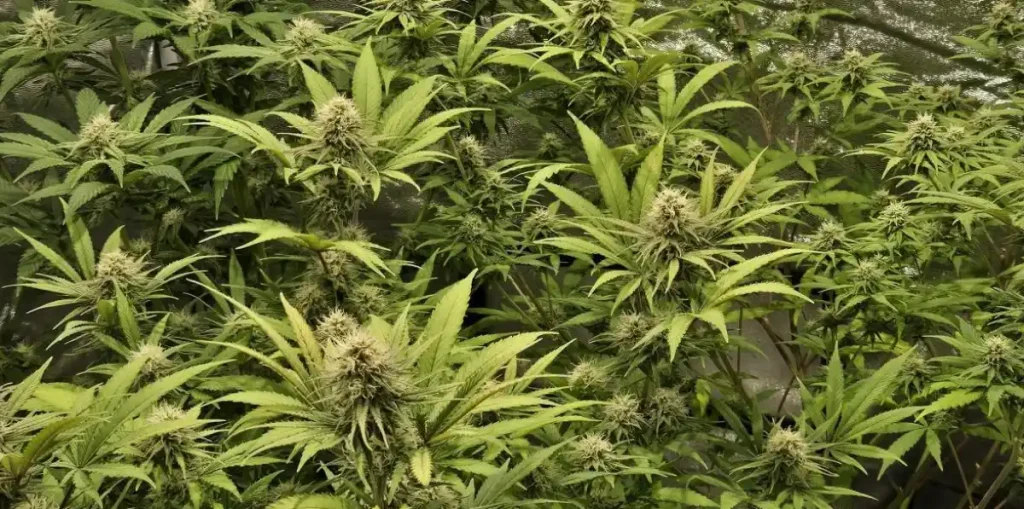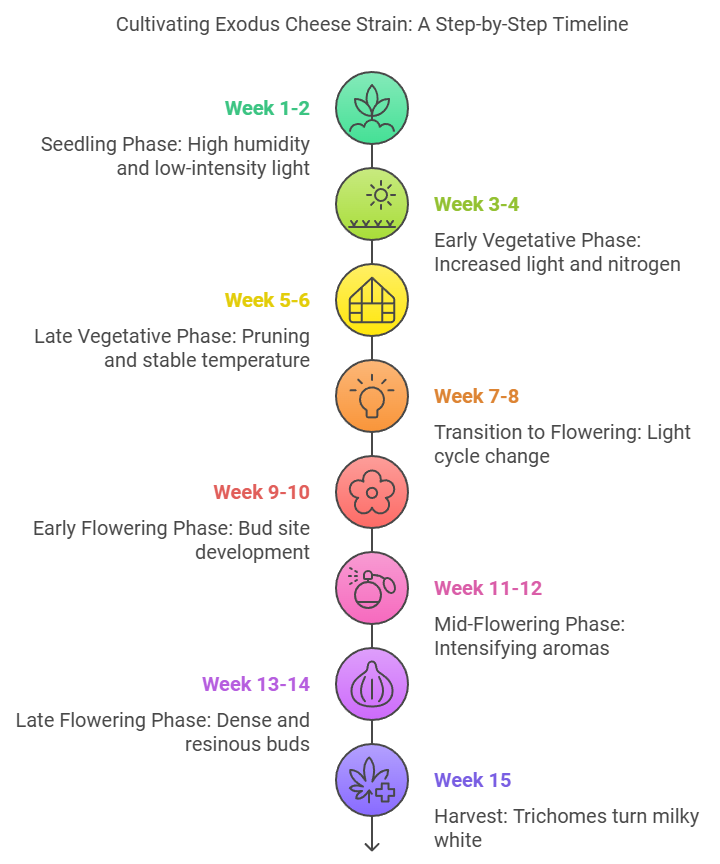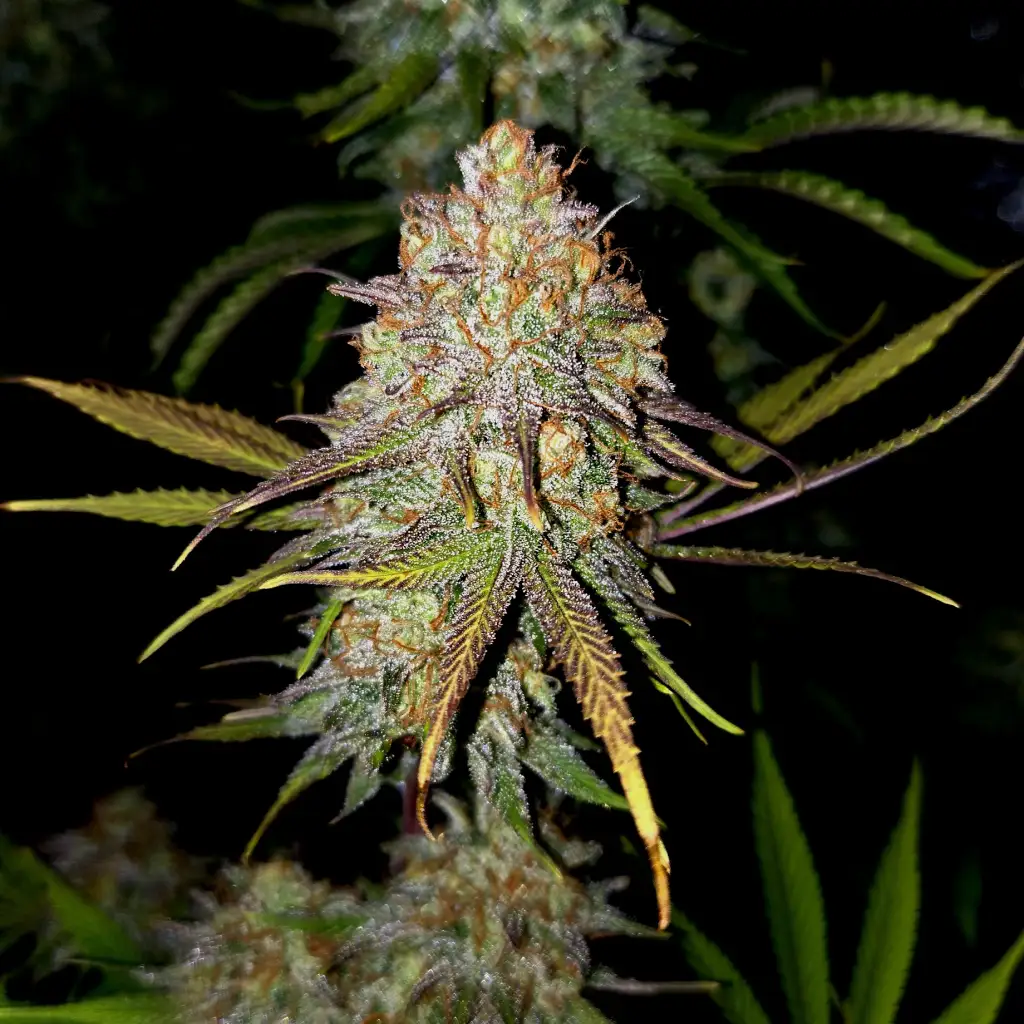Exodus Cheese Strain Description
Exodus Cheese is a legendary hybrid originating in the UK, celebrated for its pungent cheese-like aroma and balanced effects. This strain delivers a euphoric cerebral high alongside a calming body relaxation, making it a favorite for recreational and medicinal users alike. Its dense, resin-coated buds feature a rich flavor profile with notes of aged cheese, earth, and a skunky finish that cannabis enthusiasts love.
This strain is highly versatile, offering benefits for creativity, relaxation, and stress relief. Its unique aroma and balanced effects have secured Exodus Cheese’s reputation as a go-to strain for a variety of users seeking an iconic cannabis experience.
Environmental Requirements for Growing Exodus Cheese Strain
Creating the right growing environment is crucial for achieving the best yields from Exodus Cheese. This strain flourishes indoors, where temperature and humidity can be controlled precisely. Ideal temperatures range from 20°C to 26°C, with 40-50% humidity during the vegetative phase. Outdoors, Exodus Cheese thrives in warm climates with plenty of sunlight, making Mediterranean-like conditions perfect.
Outdoor growers should plant after the last frost, ensuring the strain has ample time to develop before colder weather sets in. Indoor growers benefit from controlled lighting and environmental adjustments to support robust growth throughout the plant’s lifecycle.
Setting Up the Growing Cannabis Space
A properly equipped growing space is essential for cultivating Exodus Cheese. Indoors, use reflective materials like Mylar to maximize light efficiency and maintain even coverage. Ensure good airflow with fans to reduce the risk of mold, as the strain’s dense buds can retain moisture. Outdoors, choose a location with nutrient-rich soil and ample sunlight exposure for optimal growth.
Indoor Cannabis Cultivation
Indoors, Exodus Cheese grows well in soil or hydroponic systems. High-quality LED lights ensure efficient energy use and maintain moderate temperatures. Prune regularly to improve airflow and light penetration. Using techniques like the SCROG method can maximize space and yields by training the plant to grow horizontally.
Outdoor Cannabis Cultivation
Outdoors, this strain benefits from direct sunlight for at least eight hours daily. Choose nutrient-dense soil and enrich it with compost or organic fertilizers to enhance growth. The strain’s heavy buds may require staking or support to prevent branches from breaking during flowering.
Propagation and Germination of Exodus Cheese Strain
To propagate Exodus Cheese, the paper towel method ensures a high germination success rate. Place seeds between damp paper towels in a warm, dark space until taproots appear, typically in 1-3 days. Transfer sprouted seeds into a growing medium, starting with small pots and gradually transplanting as the plant matures.
Early care is crucial; maintain temperatures between 21°C and 24°C with a humidity level of around 70%. Ensure seedlings receive adequate light and avoid overwatering to promote strong root development during this stage.
Vegetative Phase of Exodus Cheese Strain
In the vegetative stage, Exodus Cheese grows vigorously, requiring at least 18 hours of light daily. Maintain humidity at 50-60% and temperatures between 21°C and 27°C. Pruning during this phase encourages lateral growth, preventing overcrowding and enhancing airflow. Use a balanced N-P-K fertilizer with a ratio like 3-1-2 to support healthy development.
The vegetative phase is the foundation for strong yields, so attention to nutrients, water, and training techniques like low-stress training (LST) or topping can significantly impact the plant’s overall performance.
Flowering Phase of Exodus Cheese Strain
Exodus Cheese typically flowers in 8-9 weeks, with dense, aromatic buds forming during this phase. Reduce humidity to 40-50% and switch to a 12/12 light cycle to trigger flowering indoors. Outdoors, flowering begins as daylight hours naturally decrease. This phase requires high phosphorus and potassium nutrients to support bud production.
The strain’s signature cheesy aroma becomes more pronounced, requiring carbon filters indoors for odor control. Proper airflow and environmental adjustments during this phase are essential to avoid mold and maximize bud quality.
Cannabis Fertilization and Nutrition – Exodus Cheese Strain
Proper fertilization is key to healthy Exodus Cheese plants. Use nitrogen-rich fertilizers during the vegetative stage to promote lush growth. Transition to phosphorus and potassium-heavy nutrients during flowering to encourage dense, resinous buds. Organic fertilizers can enhance flavor and terpene production, resulting in a superior final product.
Avoid over-fertilizing, as excess nutrients can cause nutrient burn. Regularly flushing the growing medium during the flowering phase ensures a clean taste and reduces harshness in the cured buds, enhancing overall quality.
Pest and Disease Control for Cannabis Growing
Prevention
Preventative measures include maintaining a clean growing environment with adequate airflow and stable humidity levels. Companion planting with herbs like mint or basil can naturally deter pests. Regularly inspecting plants for early signs of pest or mold issues is critical.
Corrective Actions
If pests like spider mites or aphids appear, treat them with neem oil or insecticidal soap. For mold, carefully remove affected areas and increase airflow. Beneficial predators like ladybugs can help manage pests organically, preserving the health of your Exodus Cheese plants.

Week-by-Week Growth Plan for Exodus Cheese Strain
Week 1-2: Germination and Seedling Stage
Begin germination with the paper towel method, ensuring seeds are kept warm and moist. Once taproots emerge, transfer the seedlings into small pots with a light, nutrient-rich soil mix. Maintain temperatures between 21°C and 24°C and set humidity levels at 70% to mimic the natural growing environment. Use low-intensity grow lights, such as CFLs or LEDs, positioned 12–18 inches above the plants to avoid heat stress.
During this stage, avoid overwatering as young roots are highly sensitive. Water lightly when the topsoil feels dry, ensuring proper drainage to prevent damping-off disease. Monitor seedlings for signs of healthy growth, including vibrant green leaves and steady stem elongation.
Week 3-4: Early Vegetative Stage
As seedlings transition into vegetative growth, increase the light intensity and maintain an 18/6 light schedule (18 hours of light and 6 hours of darkness). Adjust humidity levels to 65% while keeping temperatures between 21°C and 27°C. Begin feeding plants with a balanced nutrient mix containing nitrogen, phosphorus, and potassium to support early growth.
Water consistently, ensuring the top inch of soil dries out between waterings to avoid root rot. Observe for strong leaf development and sturdy stems, which indicate a healthy start. This is also a good time to inspect for pests or nutrient deficiencies and address any issues promptly.
Week 5-6: Vegetative Growth
In this phase, Exodus Cheese will display rapid growth with a noticeable increase in foliage. Continue the 18/6 light schedule, and use nitrogen-rich fertilizers to promote leafy growth. Lower humidity to around 60% and maintain consistent temperatures between 22°C and 26°C.
To maximize yields, start employing training techniques such as low-stress training (LST) or topping. LST helps manage height and encourages horizontal growth, while topping promotes multiple bud sites. Prune lower branches to improve airflow and light penetration, reducing the risk of mold and enhancing overall plant health.
Week 7-8: Late Vegetative Phase
Prepare plants for the flowering phase by gradually lowering humidity to 55%. Continue with nitrogen-heavy fertilization, but begin incorporating small amounts of phosphorus and potassium to ease the transition. Maintain an 18/6 light schedule, ensuring light intensity is optimal for growth.
Inspect plants for even growth and correct any imbalances using training techniques. Keep the grow space clean and well-ventilated to prevent pests and diseases. By the end of this phase, plants should have a robust structure with ample bud sites ready to enter flowering.
Week 9-10: Pre-Flowering Transition
Switch the light schedule to 12/12 to trigger the flowering process. Lower humidity to 50% and transition to phosphorus-heavy nutrients to support bud development. Plants will start forming pre-flowers, which are small pistils indicating the onset of the reproductive stage.
Maintain temperatures between 21°C and 25°C and ensure proper airflow to prevent humidity buildup. This is a critical phase for bud formation, so monitor plants closely for any signs of stress or nutrient imbalances, adjusting feeding schedules as needed.
Week 11-12: Early Flowering
Buds begin forming and gradually increase in size. Reduce humidity further to 45% and maintain moderate temperatures between 20°C and 24°C. Use a flowering nutrient mix rich in phosphorus and potassium while minimizing nitrogen intake to focus energy on bud production.
Consider installing carbon filters if growing indoors, as the strain’s iconic cheesy aroma will intensify. Regularly inspect plants for mold or pests, especially in dense foliage areas, to ensure healthy growth throughout this stage.
Week 13-14: Mid Flowering
Buds thicken, trichomes become visible, and aroma reaches its peak intensity. Keep humidity at 40% to avoid mold and mildew, and maintain optimal temperatures between 20°C and 23°C. Stake or support heavy branches to prevent snapping under the weight of the developing buds.
Continue with flowering-specific nutrients and ensure consistent watering practices. Proper ventilation is crucial at this stage to maintain a stable environment and enhance resin production.
Week 15-16: Late Flowering
In the final flowering stage, reduce humidity to 35-40% and flush plants with plain water to remove nutrient buildup. This improves the final taste and smoothness of the buds. Monitor trichomes daily—harvest when they are mostly cloudy with a few amber hues, signaling peak potency.
Ensure the grow space remains clean and free from pests, as any issues at this stage could significantly impact the quality of the harvest. Adjust feeding and watering schedules to prevent over-saturation.
Week 17-18: Ripening Phase
During this phase, trichomes will reach their optimal maturity. Harvest buds when pistils darken and curl inward. Cut plants at the base and hang branches in a dark, well-ventilated space for drying. Maintain temperatures around 20°C and humidity at 50% during the drying process.
Once dried, trim excess foliage and begin curing buds in airtight jars. Open the jars daily for 10-15 minutes during the first two weeks to release moisture and prevent mold. Proper curing over 2-4 weeks enhances flavor, potency, and smoothness.
FAQs About Exodus Cheese Strain
What is the THC percentage of Exodus Cheese Strain?
Exodus Cheese Strain typically contains 18-20% THC. This balanced potency delivers a euphoric high that is suitable for both novice and experienced users. It offers a long-lasting effect that starts with a cerebral uplift and transitions into a deeply relaxing body buzz.
How long does it take for Exodus Cheese Strain to flower?
The flowering period for Exodus Cheese Strain is approximately 8-9 weeks indoors. Outdoor growers can expect to harvest in late September or early October, depending on the local climate. Its relatively short flowering time makes it a favorite among growers seeking a quick turnaround.
What flavors and terpenes are present in Exodus Cheese Strain?
Exodus Cheese boasts a signature cheesy aroma with earthy and skunky undertones. Its terpene profile includes caryophyllene, which contributes to its spicy kick, and myrcene, responsible for its earthy aroma. These terpenes combine to create a unique and pungent flavor profile.
Can Exodus Cheese Strain be grown both indoors and outdoors?
Yes, Exodus Cheese adapts well to both indoor and outdoor cultivation. Indoors, it thrives under controlled conditions with an 18/6 vegetative light schedule and a 12/12 flowering cycle. Outdoors, it prefers warm climates with plenty of sunlight. Ensure proper ventilation and humidity control for optimal results.
What are the medicinal benefits of Exodus Cheese Strain?
Exodus Cheese is known for its ability to alleviate stress, anxiety, and pain. Its balanced effects provide mental clarity while relaxing the body, making it ideal for evening use. Additionally, it can help with appetite stimulation and mild insomnia, offering therapeutic benefits for a variety of conditions.


